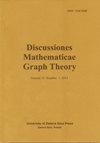用和、多集或积来区分适当的2-标记
IF 0.5
4区 数学
Q3 MATHEMATICS
引用次数: 0
摘要
给定一个图G, G的k标记是一个赋值:E(G)→{1,…。, k}的标签从{1,…, k}到边。我们说,如果没有两个相邻的G的顶点分别对应于标签的和、多集或积,则r是s-固有的、m-固有的或p-固有的。正确的标签是区分标签领域的一部分,在过去的几十年里,特别是在众所周知的1-2-3猜想的背景下,已经受到了相当多的关注。近年来,该领域的主要问题取得了相当大的进展,值得注意的是,解决了m-固有和p-固有标记的1-2-3猜想的类似问题。这主要是由于全球对这些类型的标签有了更好的了解。在这篇文章中,我们关注Paramaguru和Sampathkumar提出的一个问题,他们问具有m-固有2标记的图是否总是承认s-固有2标记。最近路易斯给出了一个否定的答案,他提供了无数反例。我们给出了一个更一般的结果,表明识别有m-固有2标记但没有s-固有2标记的图是一个np困难问题。我们还证明了m-固有2标记和p-固有2标记的类似结果,并提出了进一步研究该主题的几个方向。本文章由计算机程序翻译,如有差异,请以英文原文为准。
On Proper 2-Labellings Distinguishing by Sums, Multisets or Products
Abstract Given a graph G, a k-labelling ℓ of G is an assignment ℓ : E(G) → {1, . . . , k} of labels from {1, . . . , k} to the edges. We say that ℓ is s-proper, m-proper or p-proper, if no two adjacent vertices of G are incident to the same sum, multiset or product, respectively, of labels. Proper labellings are part of the field of distinguishing labellings, and have been receiving quite some attention over the last decades, in particular in the context of the well-known 1-2-3 Conjecture. In recent years, quite some progress was made towards the main questions of the field, with, notably, the analogues of the 1-2-3 Conjecture for m-proper and p-proper labellings being solved. This followed mainly from a better global understanding of these types of labellings. In this note, we focus on a question raised by Paramaguru and Sampathkumar, who asked whether graphs with m-proper 2-labellings always admit s-proper 2-labellings. A negative answer to this question was recently given by Luiz, who provided infinite families of counterexamples. We give a more general result, showing that recognising graphs with m-proper 2-labellings but no s-proper 2-labellings is an NP-hard problem. We also prove a similar result for m-proper 2-labellings and p-proper 2-labellings, and raise a few directions for further work on the topic.
求助全文
通过发布文献求助,成功后即可免费获取论文全文。
去求助
来源期刊

Discussiones Mathematicae Graph Theory
MATHEMATICS-
CiteScore
2.20
自引率
0.00%
发文量
22
审稿时长
53 weeks
期刊介绍:
The Discussiones Mathematicae Graph Theory publishes high-quality refereed original papers. Occasionally, very authoritative expository survey articles and notes of exceptional value can be published. The journal is mainly devoted to the following topics in Graph Theory: colourings, partitions (general colourings), hereditary properties, independence and domination, structures in graphs (sets, paths, cycles, etc.), local properties, products of graphs as well as graph algorithms related to these topics.
 求助内容:
求助内容: 应助结果提醒方式:
应助结果提醒方式:


